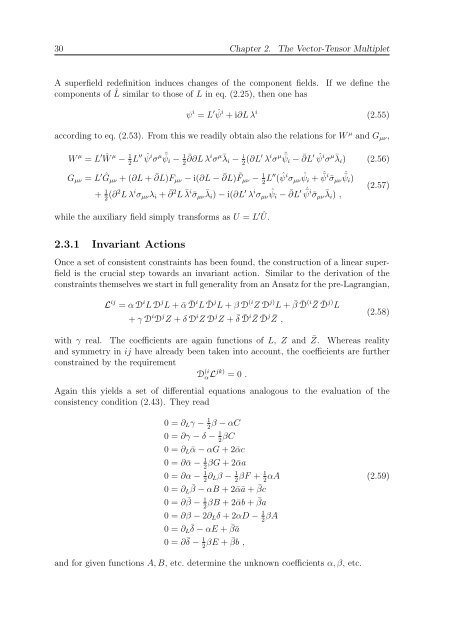N=2 Supersymmetric Gauge Theories with Nonpolynomial Interactions
N=2 Supersymmetric Gauge Theories with Nonpolynomial Interactions
N=2 Supersymmetric Gauge Theories with Nonpolynomial Interactions
You also want an ePaper? Increase the reach of your titles
YUMPU automatically turns print PDFs into web optimized ePapers that Google loves.
30 Chapter 2. The Vector-Tensor Multiplet<br />
A superfield redefinition induces changes of the component fields. If we define the<br />
components of ˆ L similar to those of L in eq. (2.25), then one has<br />
ψ i = L ′ ˆ ψ i + i∂L λ i<br />
(2.55)<br />
according to eq. (2.53). From this we readily obtain also the relations for W µ and Gµν,<br />
W µ = L ′ ˆ W µ − 1<br />
2 L′′ ˆ ψ i σ µ ˆ¯ ψi − 1<br />
2 ¯ ∂∂L λ i σ µ¯ λi − i<br />
2 (∂L′ λ i σ µ ˆ¯ ψi − ¯ ∂L ′ ˆ ψ i σ µ¯ λi) (2.56)<br />
Gµν = L ′ ˆ Gµν + (∂L + ¯ ∂L)Fµν − i(∂L − ¯ ∂L) ˜ Fµν − 1<br />
2 L′′ ( ˆ ψ i σµν ˆ ψi + ˆ¯ ψ i ¯σµν ˆ¯ ψi)<br />
+ 1<br />
2 (∂2 L λ i σµνλi + ¯ ∂ 2 L ¯ λ i ¯σµν ¯ λi) − i(∂L ′ λ i σµν ˆ ψi − ¯ ∂L ′ ˆ¯ ψ i ¯σµν ¯ λi) ,<br />
while the auxiliary field simply transforms as U = L ′ Û.<br />
2.3.1 Invariant Actions<br />
(2.57)<br />
Once a set of consistent constraints has been found, the construction of a linear superfield<br />
is the crucial step towards an invariant action. Similar to the derivation of the<br />
constraints themselves we start in full generality from an Ansatz for the pre-Lagrangian,<br />
L ij = α D i L D j L + ¯α ¯ D i L ¯ D j L + β D (i Z D j) L + ¯ β ¯ D (i ¯ Z ¯ D j) L<br />
+ γ D i D j Z + δ D i Z D j Z + ¯ δ ¯ D i ¯ Z ¯ D j ¯ Z ,<br />
(2.58)<br />
<strong>with</strong> γ real. The coefficients are again functions of L, Z and ¯ Z. Whereas reality<br />
and symmetry in ij have already been taken into account, the coefficients are further<br />
constrained by the requirement<br />
D (i<br />
αL jk) = 0 .<br />
Again this yields a set of differential equations analogous to the evaluation of the<br />
consistency condition (2.43). They read<br />
0 = ∂Lγ − 1β<br />
− αC<br />
2<br />
0 = ∂γ − δ − 1<br />
2βC 0 = ∂L ¯α − αG + 2¯αc<br />
0 = ∂ ¯α − 1βG<br />
+ 2¯αa<br />
2<br />
0 = ∂α − 1<br />
2∂Lβ − 1<br />
2<br />
0 = ∂L ¯ β − αB + 2¯αā + ¯ βc<br />
0 = ∂ ¯ β − 1<br />
2 βB + 2¯αb + ¯ βa<br />
0 = ∂β − 2∂Lδ + 2αD − 1<br />
2 βA<br />
0 = ∂L ¯ δ − αE + ¯ βā<br />
0 = ∂ ¯ δ − 1<br />
2 βE + ¯ βb ,<br />
1 βF + αA (2.59)<br />
2<br />
and for given functions A, B, etc. determine the unknown coefficients α, β, etc.

















